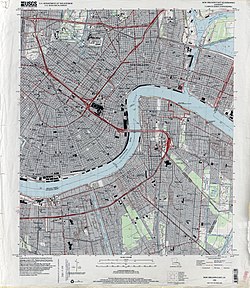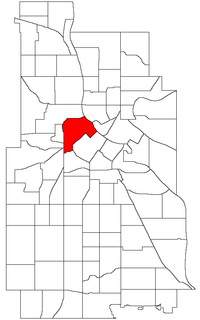
The North Loop, also commonly called The Warehouse District, is a neighborhood of the Central community of Minneapolis, Minnesota that was Minneapolis’s main commercial district during the city's years as a midwestern shipping hub. Although only a little commercial shipping is still done in the neighborhood, the historic warehouses still dominate the neighborhood. Some of these buildings have been repurposed into restaurants, shops, and apartments.

Streamline Moderne is an international style of Art Deco architecture and design that emerged in the 1930s. Inspired by aerodynamic design, it emphasized curving forms, long horizontal lines, and sometimes nautical elements. In industrial design, it was used in railroad locomotives, telephones, toasters, buses, appliances, and other devices to give the impression of sleekness and modernity.

Krippendorf-Dittman Company is a registered historic building in Cincinnati, Ohio, listed in the National Register on March 3, 1980.

The Eggerss–O'Flyng Building is located at 801 South 15th Street in downtown Omaha, Nebraska, United States. The building was listed on the National Register of Historic Places in 1991, and named an Omaha Landmark on March 17, 1992.

Mihran Mesrobian was an Armenian-American architect whose career spanned over fifty years and in several countries. Having received an education in the Academy of Fine Arts in Constantinople, Mesrobian began his career as an architect in Smyrna and in Constantinople. While in Constantinople, Mesrobian served as the palace architect to the last Ottoman Sultan, Mehmed V.

The Decker Building is a commercial building located at 33 Union Square West in Manhattan, New York City. The structure was completed in 1892 for the Decker Brothers piano company, and designed by John H. Edelmann. From 1968 to 1973, it served as the location of the artist Andy Warhol's studio, The Factory. The Decker Building was designated a New York City landmark in 1988, and was added to the National Register of Historic Places in 2003.

The Hotel Clovis is a ten-story former hotel in Clovis, New Mexico, United States. Designed by architect Robert Merrell, the Art Deco structure was opened as a hotel on October 20, 1931. Hotel Clovis was added to the National Register of Historic Places in 1984.

The Midtown Woodward Historic District is a historic district located along Woodward Avenue in Detroit, Michigan. Structures in the district are located between 2951 and 3424 Woodward Avenue, and include structures on the corner of Charlotte Street and Peterboro Street. The district was admitted to the National Register of Historic Places in 2008.

The Crescent Warehouse Historic District is a 10.5-acre (4.2 ha) historic district in Downtown Davenport, Iowa, United States. The district is a collection of multi-story brick structures that formerly housed warehouses and factories. Most of the buildings have been converted into loft apartments. The district was listed on the National Register of Historic Places in 2003.
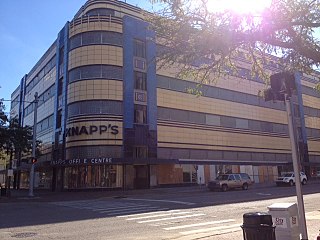
The J.W. Knapp Company Building is a historic five-story, 190,000-square-foot (18,000 m2) Streamline Moderne building in Lansing, Michigan, United States. Designed by Orlie Munson of the Bowd–Munson Company, which also designed several other Art Deco landmarks in Lansing, including the Ottawa Street Power Station, it was constructed by the Christman Company in 1937 through 1938. The curvilinear look of the streamlined structure comes from huge plates of concrete faced with enamel, called "Maul Macotta", a copyrighted product of the Maul Macotta Company and prismatic glass brick windows. Alternating horizontal bands of yellow macotta and glass block are interrupted by vertical blue macotta pylons, rising from the building's four principal entrances. The pylons are pierced by windows. The entrance portals, display window aprons, and decorative banding are dark blue macotta. Red, yellow and blue spandrels, incorporating the letter "K" as a design element, decorate the entrance portals.

Poughkeepsie Underwear Factory is a historic factory building located at Poughkeepsie, Dutchess County, New York. It was built in 1874 and is a 3+1⁄2-story, eight-bay brick building. It was expanded about 1887.

The H. J. Heinz Company complex, part of which is currently known as Heinz Lofts, is a historic industrial complex in the Troy Hill neighborhood of Pittsburgh, Pennsylvania. The buildings were built by the H. J. Heinz Company from 1907 through 1958. The complex is listed on the National Register of Historic Places (NRHP) and five of the buildings are listed as a Pittsburgh History and Landmarks Foundation Historic Landmark.

The Hollywood Theater is a historic theater building in Minneapolis, Minnesota, United States, which is listed on the U.S. National Register of Historic Places. The Art Deco theater building opened on October 26, 1935, and the marquee proclaimed it the "Incomparable Showcase of the Northwest". The theater, designed by architects Jack Liebenberg and Seeman Kaplan, had a generous budget that allowed for elaborate decoration in the Streamline Deco style of design; its facade and structure made a "powerful statement of geometric mass punctuated by the entrance, exits, and three small windows that served the projection booth." Liebenberg and Kaplan went on to design the Riverview Theatre in Minneapolis and the Terrace Theatre in Robbinsdale. The building featured a tall vertical sign, a patterned terrazzo floor, gilded pillars, and acoustical tiles in geometric patterns. It had a seating capacity of just under 1000. Much of the interior features are influenced by the Zig-Zag Moderne and Streamline Moderne styles. The exterior is built of smooth Kasota limestone with vertical lines that transition to horizontal.

The Des Moines Building is an historic building located in downtown Des Moines, Iowa, United States. It was built in 1930 based on the designs of the Des Moines architectural firm of Proudfoot, Rawson, Souers & Thomas. It is a combination of the Art deco and Art Moderne styles. The 14-story structure rises to a height of 190 feet (58 m). The former office building was abandoned and in May 2011 the city of Des Moines declared it a public nuisance so as to acquire it to be redeveloped. In November of the same year they sold the building for $150,000 to Des Moines Apartments, LP who developed it into 146 loft apartments. It was listed on the National Register of Historic Places in 2013. The basement is home to a recreational room as well as a workout room. The rooftop is accessible via the 14th floor and has a great 360 degree view of Des Moines. The building is also connected to the city's extensive skywalk system.
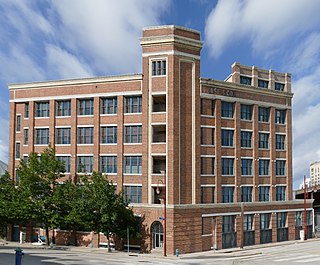
The National Biscuit Company Building, located at 15 North Chenevert in Houston, Texas, was built for Nabisco in 1910, and listed on the National Register of Historic Places on February 20, 1998. The structure was converted to apartments and is now known as City View Lofts.
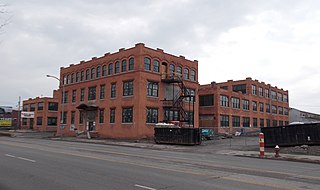
Taylor Signal Company-General Railway Signal Company is a historic industrial complex located in Buffalo, Erie County, New York. It was designed by the architectural firm of Esenwein & Johnson and built between 1902 and 1906. The daylight factory complex consists of a rectangular two and three-story brick factory building with a central light court and wings. It has a three-story brick office building fronting on Elmwood Avenue and connected to the factory by a hyphen. The office building features Gothic Revival style design elements. The complex housed the Taylor Signal Company/General Railway Signal Company until 1907, when operations were moved to Rochester, New York. Afterwards, it housed a number of manufacturing companies including the Century Telephone Construction Company, General Drop Forge Company, Curtiss Aeroplane and Motor Company, and Lippard-Stewart Motor Car Company. The complex has been renovated to house a hotel, banquet facility, and loft apartments.

The architecture of Jacksonville is a combination of historic and modern styles reflecting the city's early position as a regional center of business. According to the National Trust for Historic Preservation, there are more buildings built before 1967 in Jacksonville than any other city in Florida, but it is also important to note that few structures in the city center predate the Great Fire of 1901. Numerous buildings in the city have held state height records, dating as far back as 1902, and last holding a record in 1981.

H. Lauter Company Complex, also known as J. Solotken Company, Lauter Lofts, and Harding Street Lofts, is a historic factory complex located at Indianapolis, Indiana. It was built between 1894 and 1912, and includes the South Factory, the North Factory, and the Office Building. The factory buildings are in the Italianate and the office building is in the Classical Revival style. The North Factory is a four-story brick building with a raised full basement constructed sometime between 1908 and 1912. The Office Building is a two-story brick building constructed between 1899 and 1908 and has a truncated hipped roof. The four-story, "U"-shaped core of the South Factory was built in two phases; the eastern portion between 1894 and 1898 and the western portion in 1899. The H. Lauter Company furniture manufacturer began in 1894 and they continued to operate at the location until 1936. The buildings have been converted to condominiums and apartments.

The Edgewater in Madison, Wisconsin is a hotel which opened in 1948. It was listed on the National Register of Historic Places in 1997 as part of the Mansion Hill Historic District.
The M.C. Kiser Company Building is a historic building in Atlanta, Georgia, United States. Located in the South Downtown neighborhood, it was built in 1923 as a shoe factory, converted to apartments in 2017, and added to the National Register of Historic Places in 2019.

